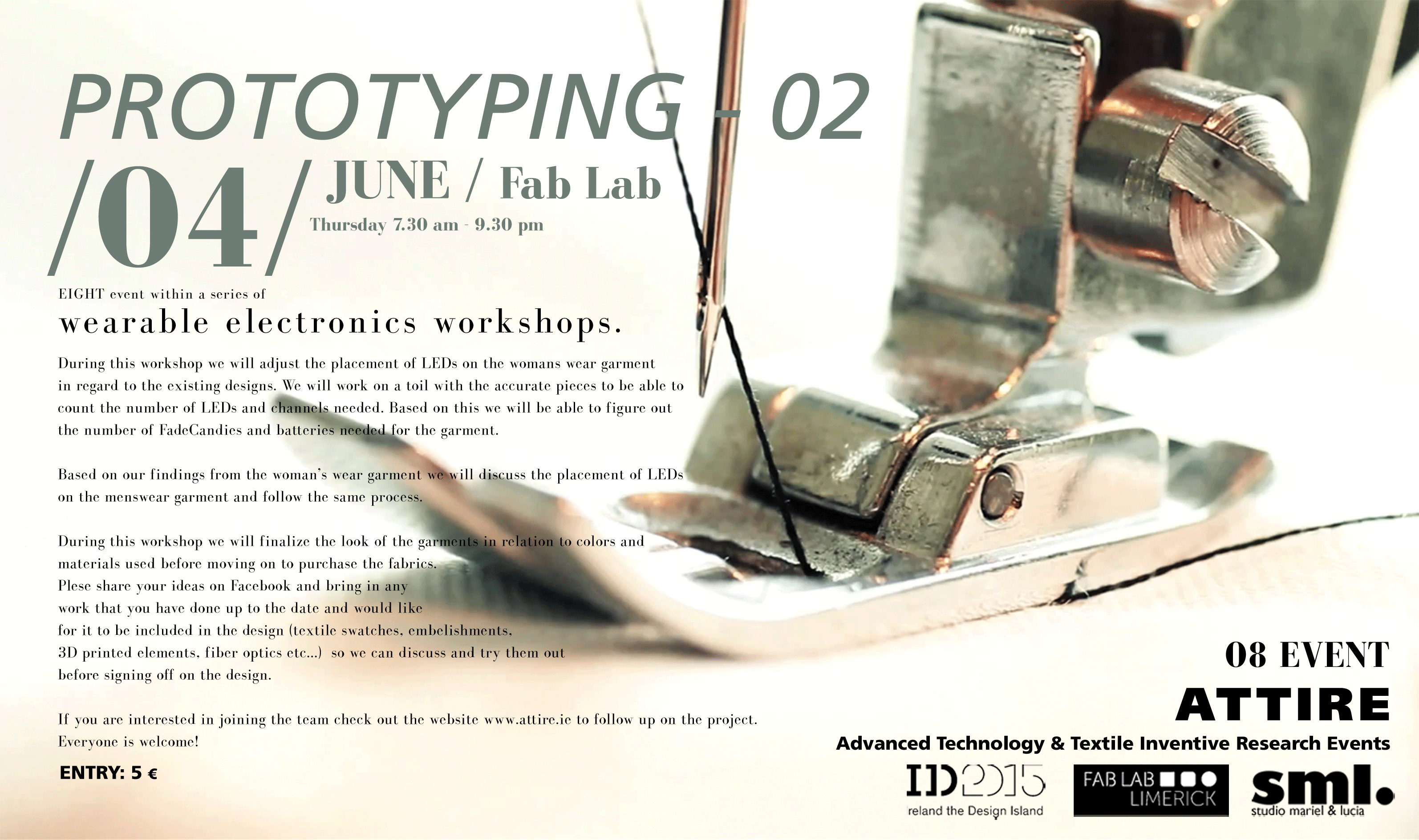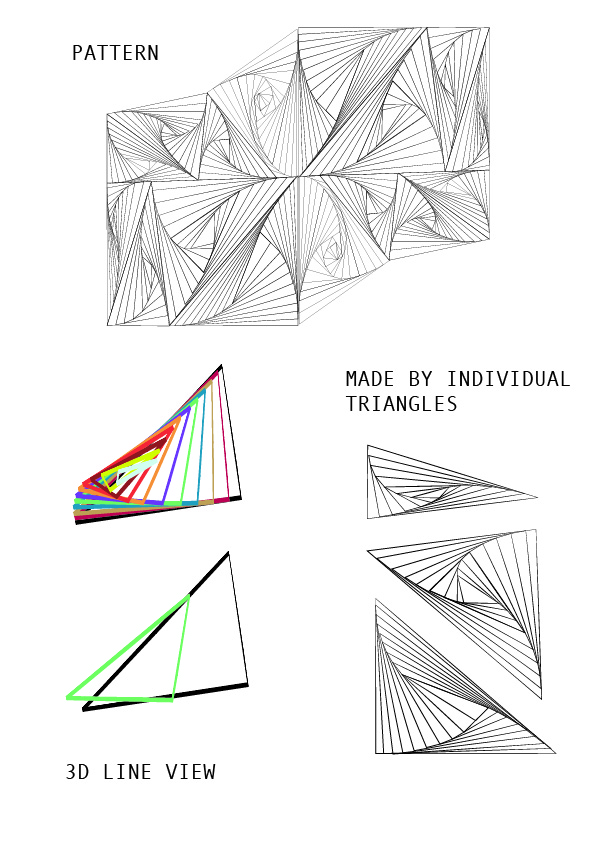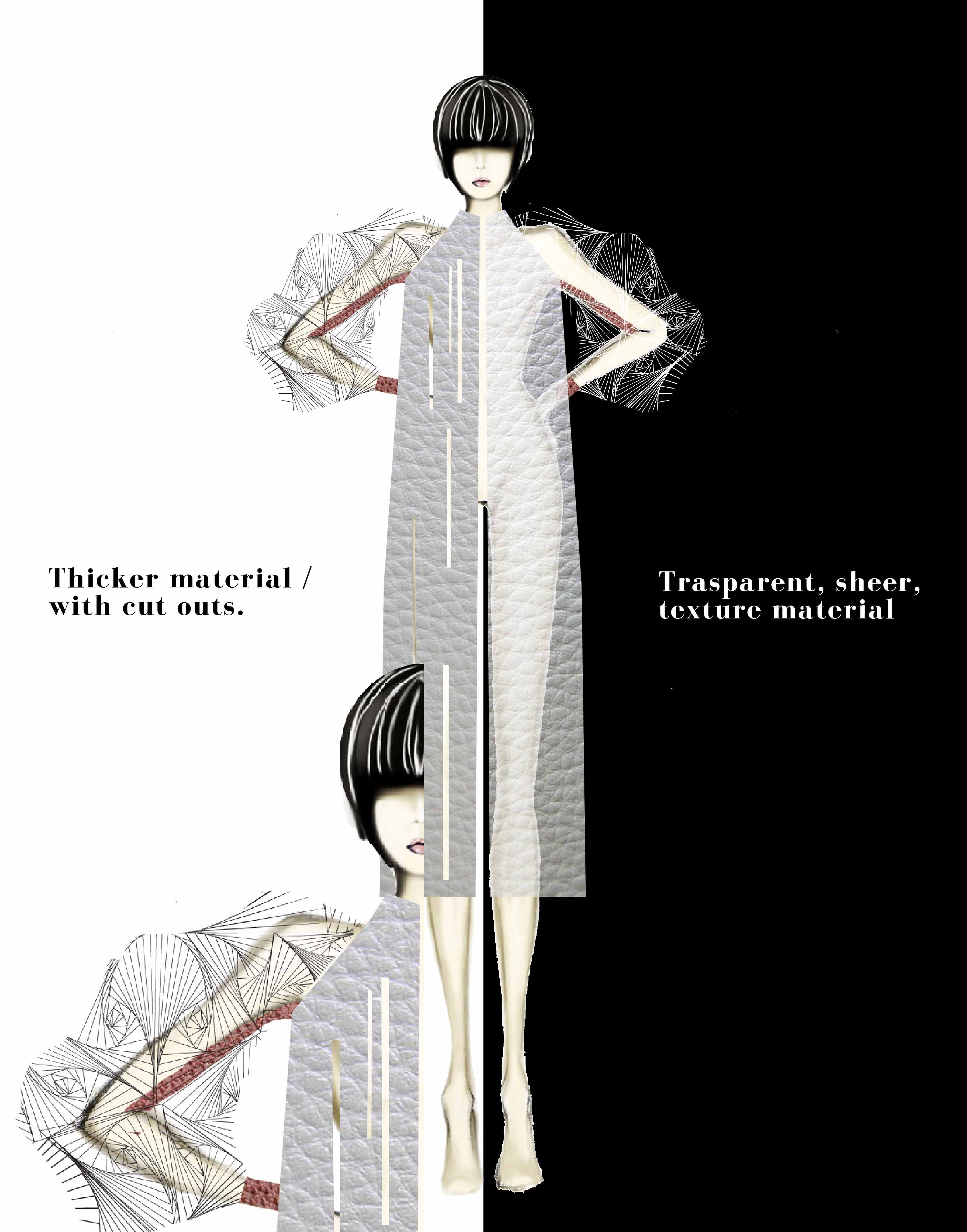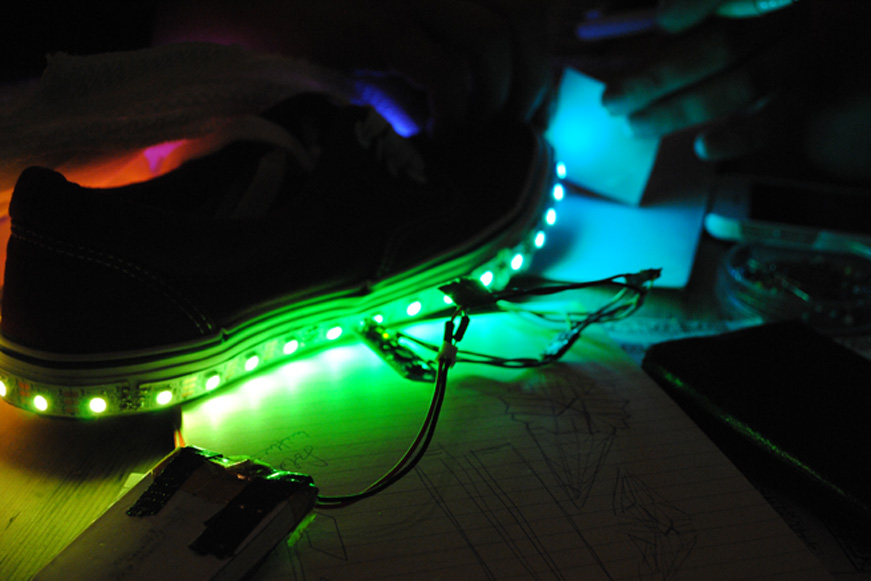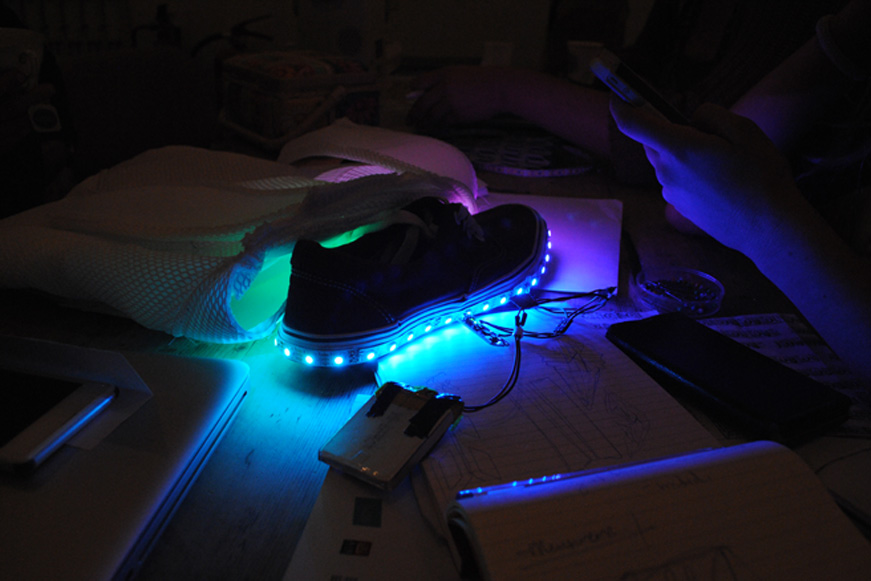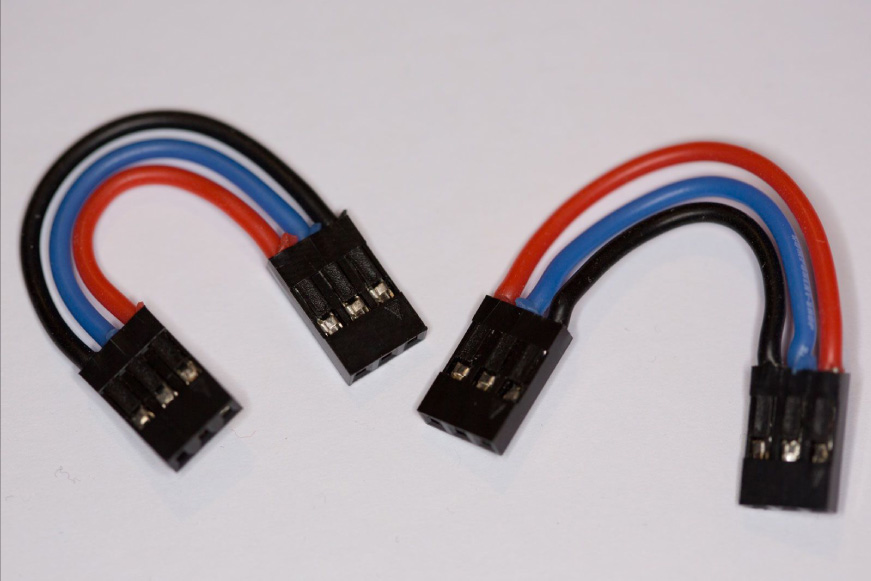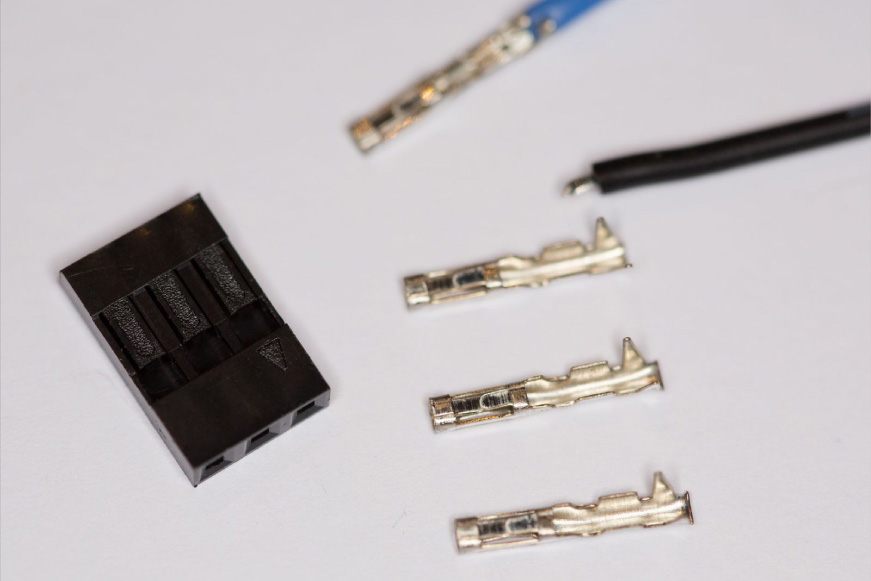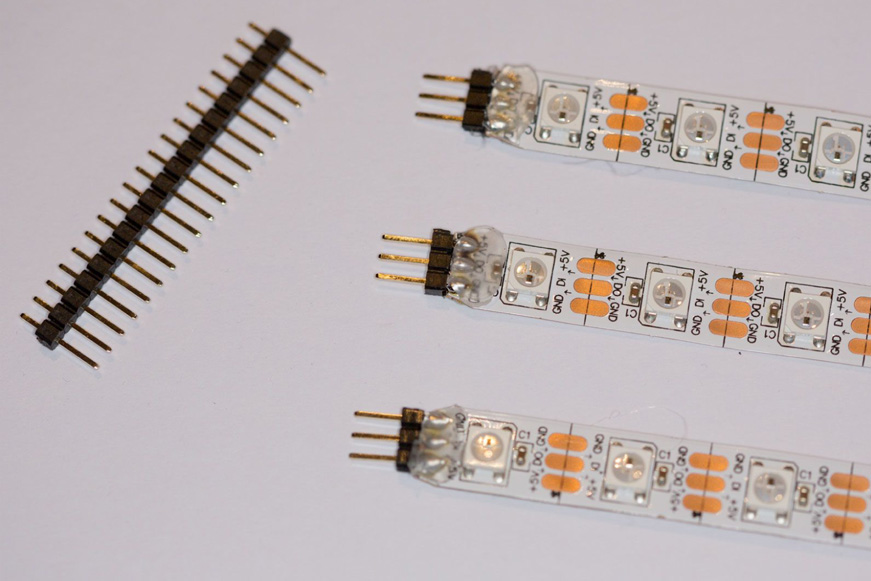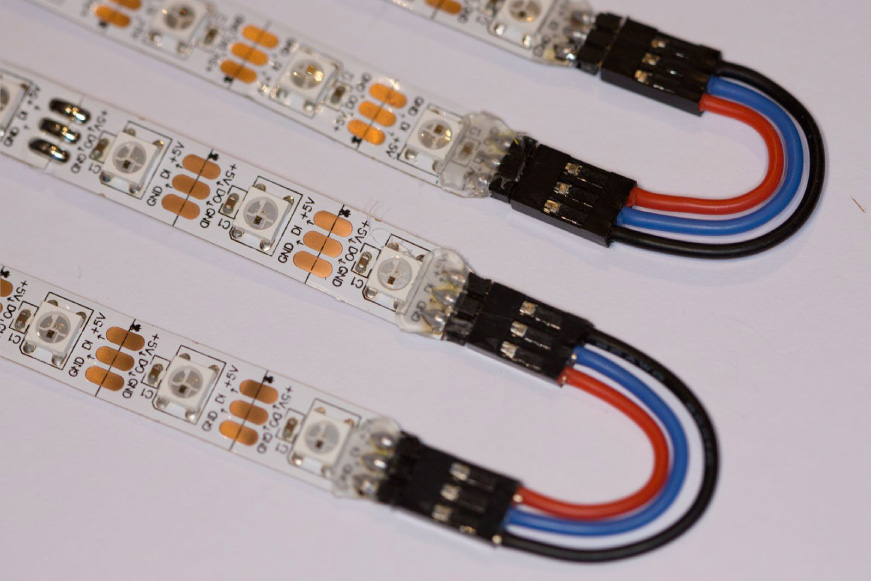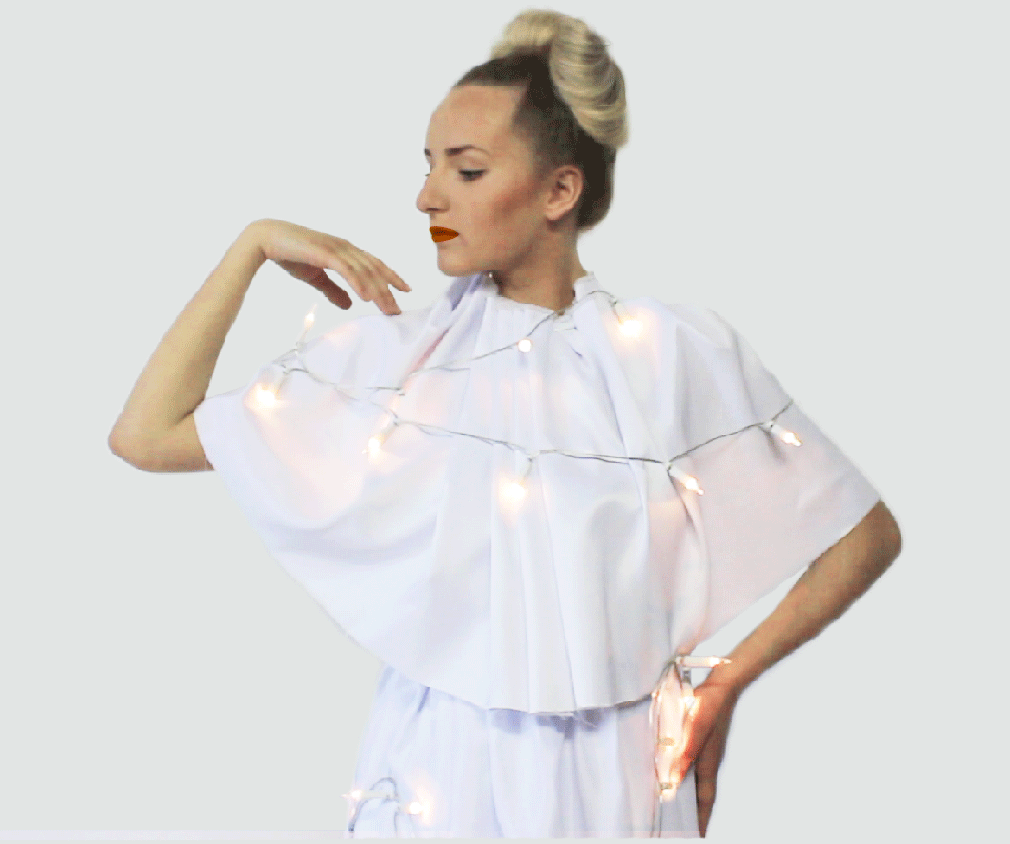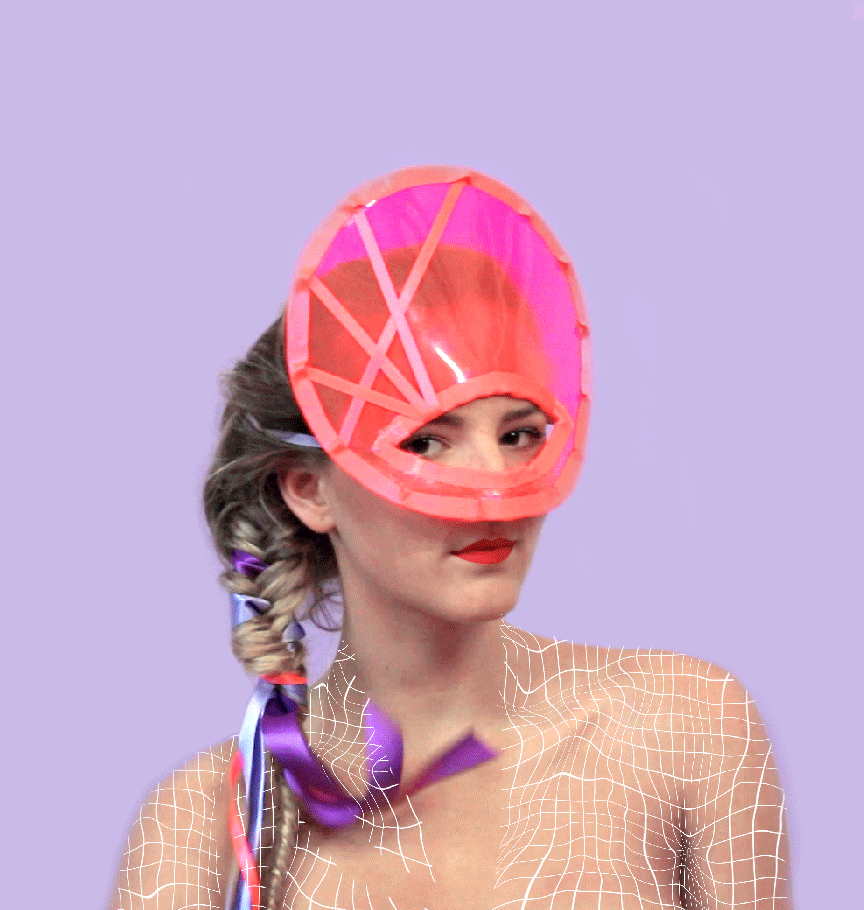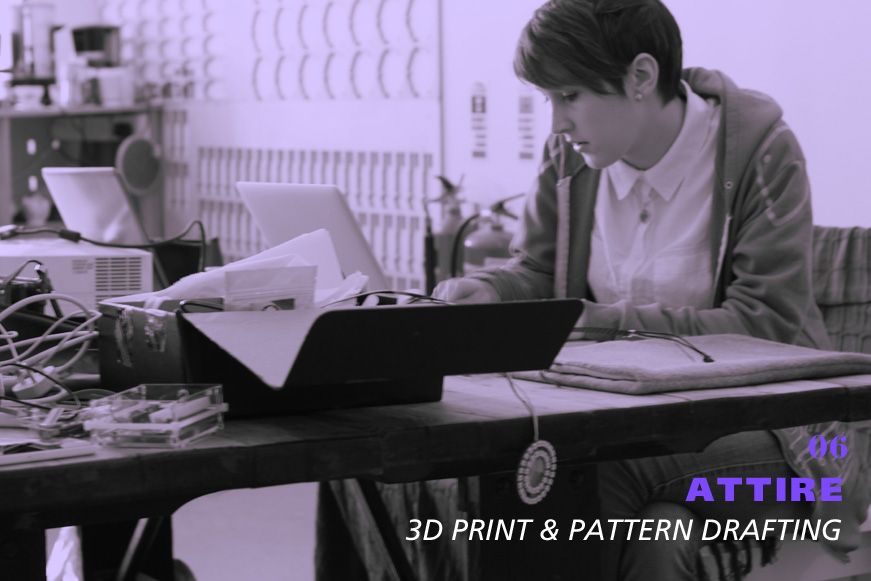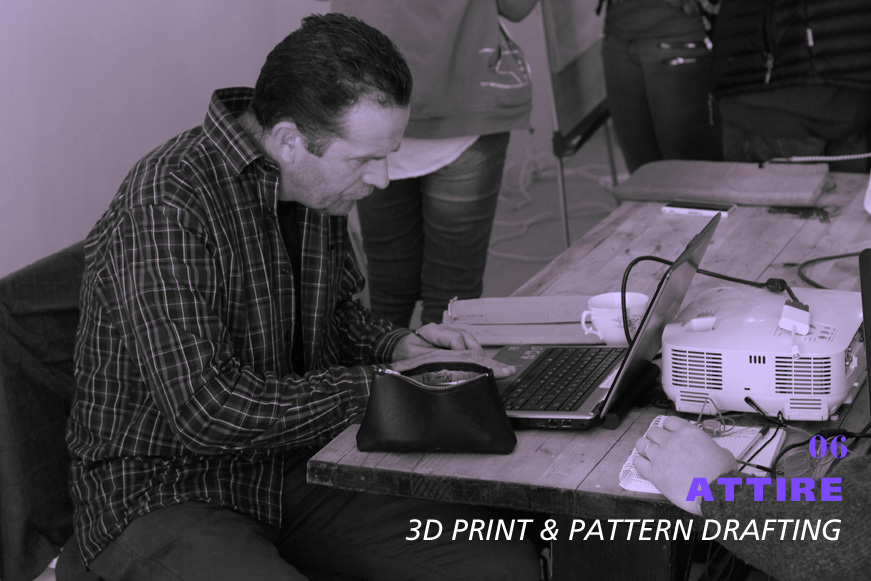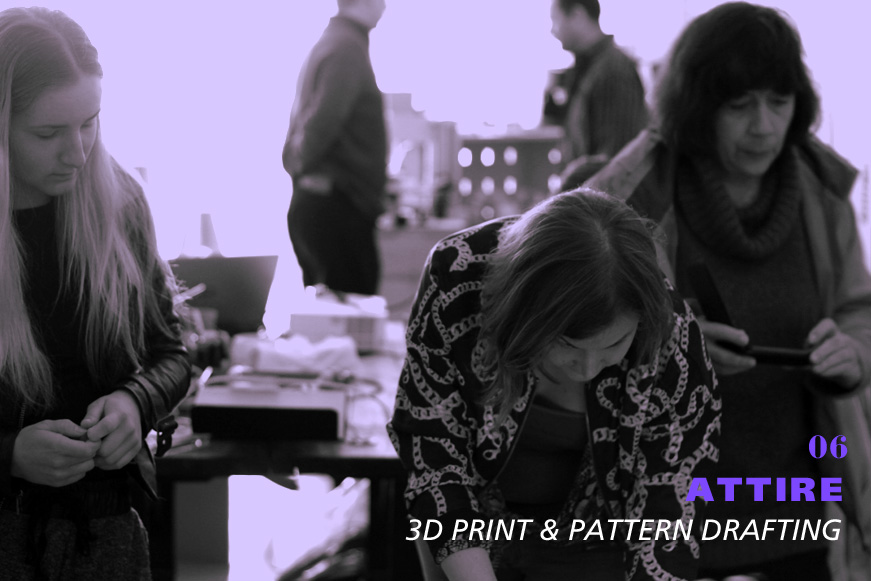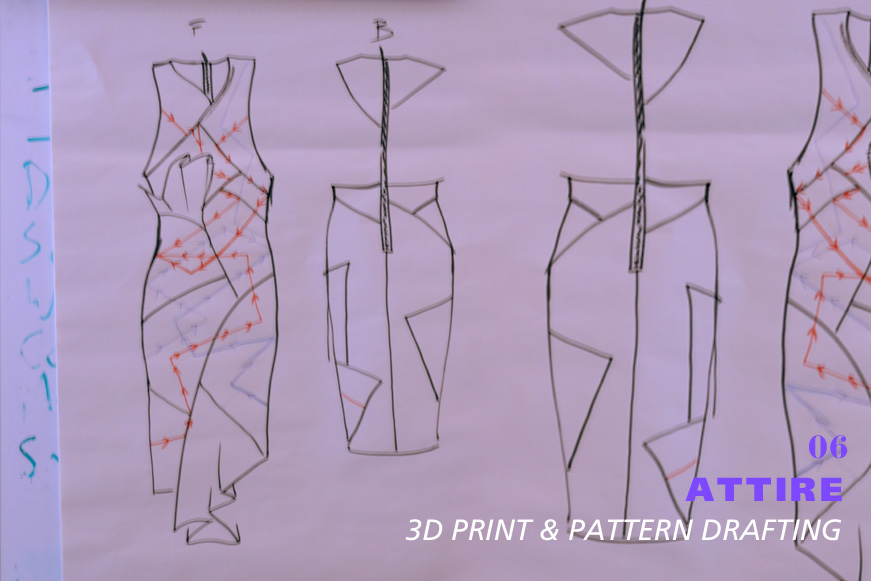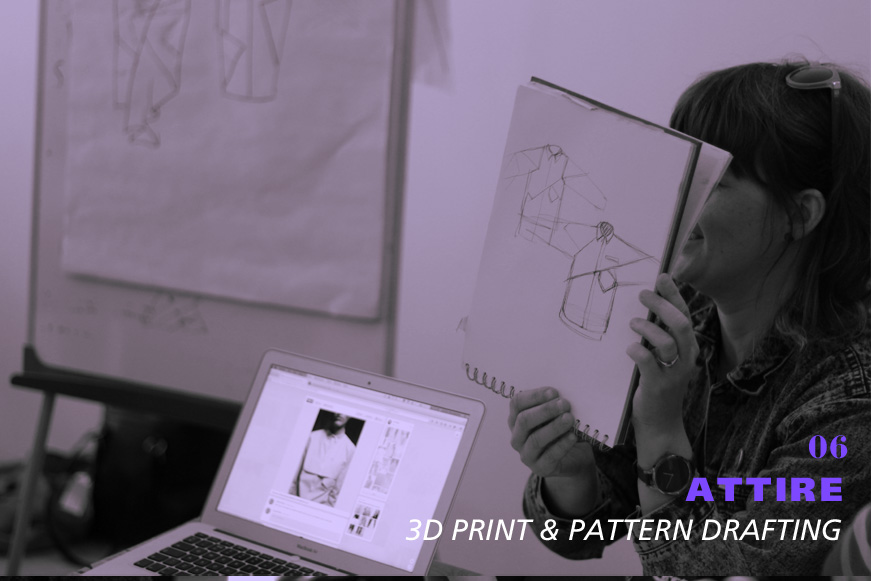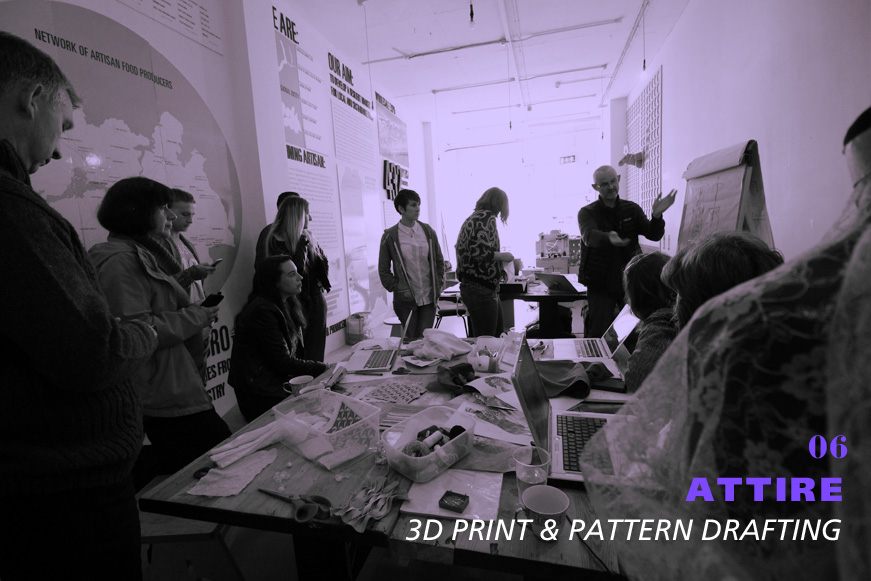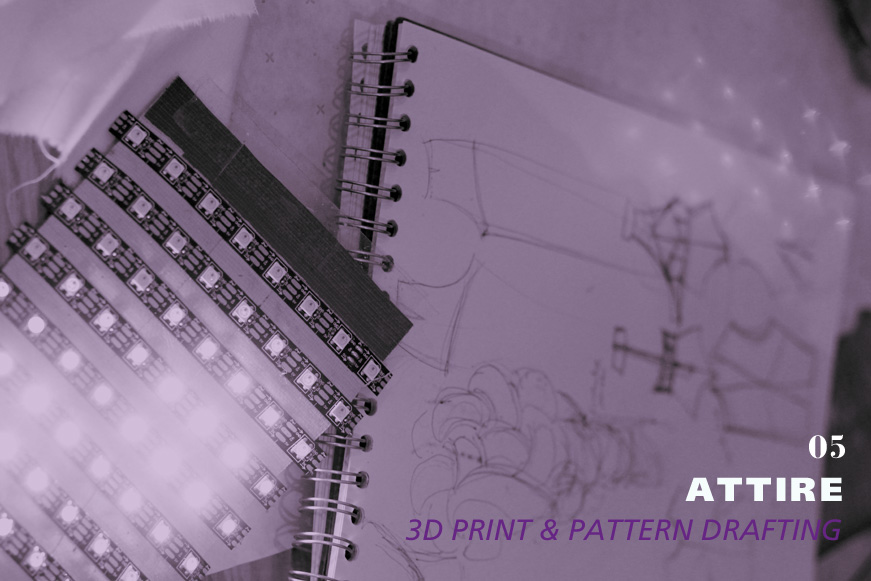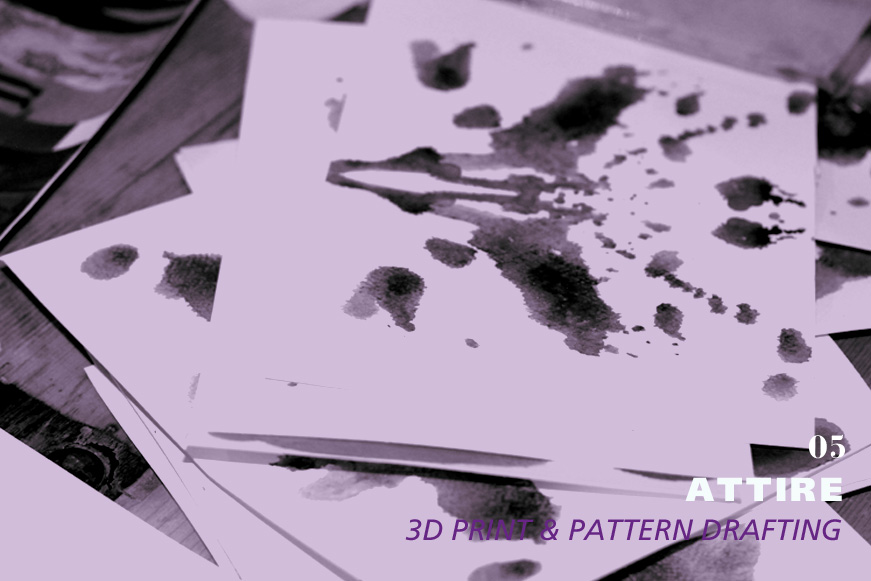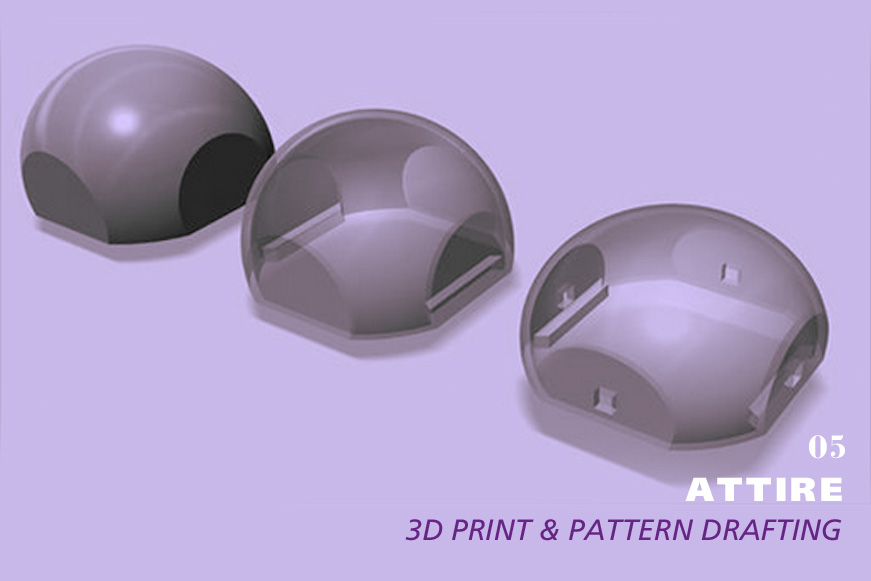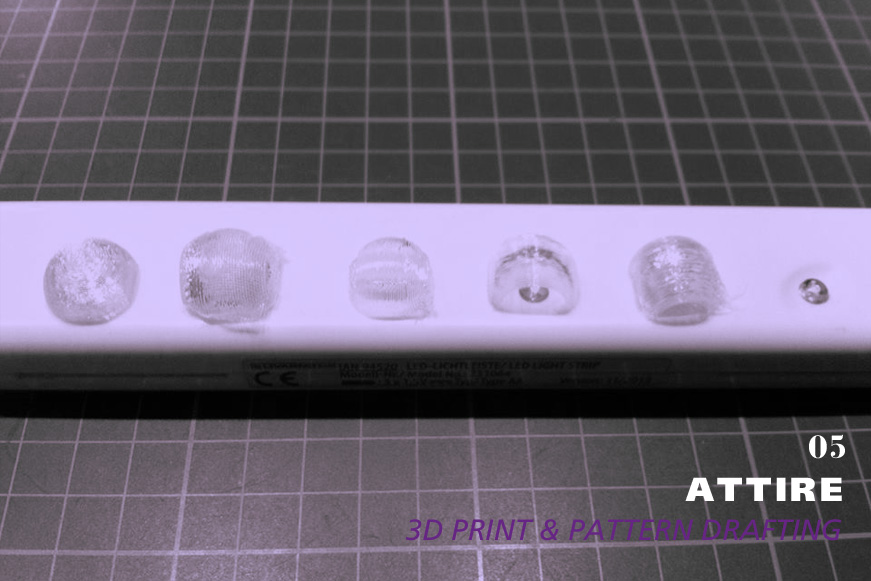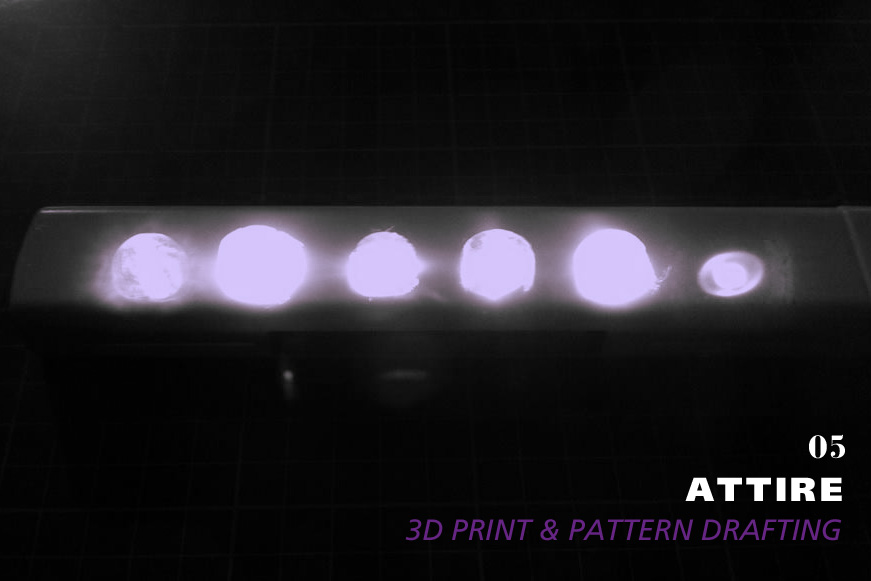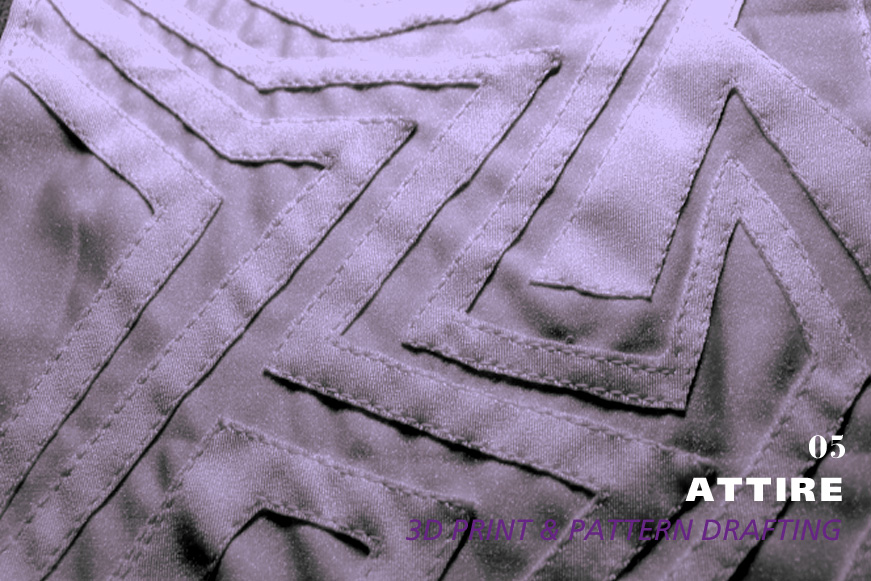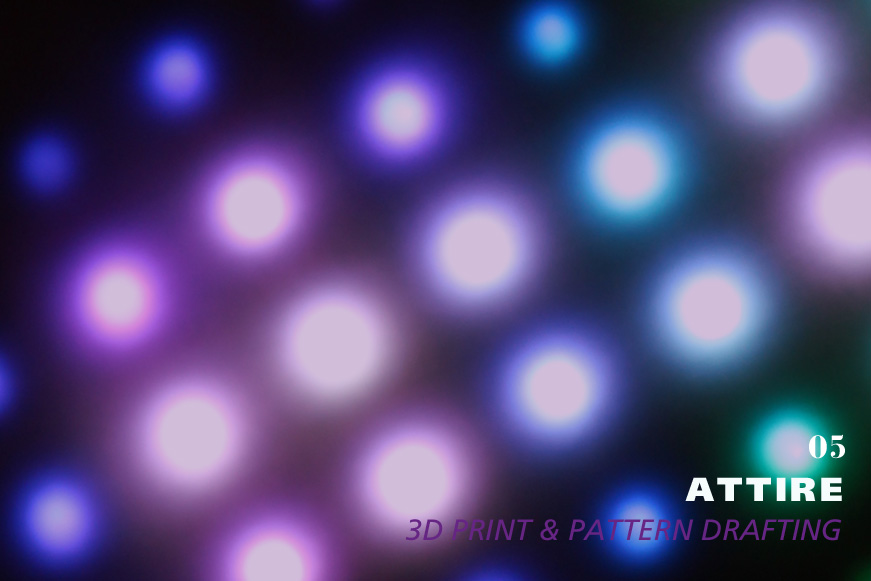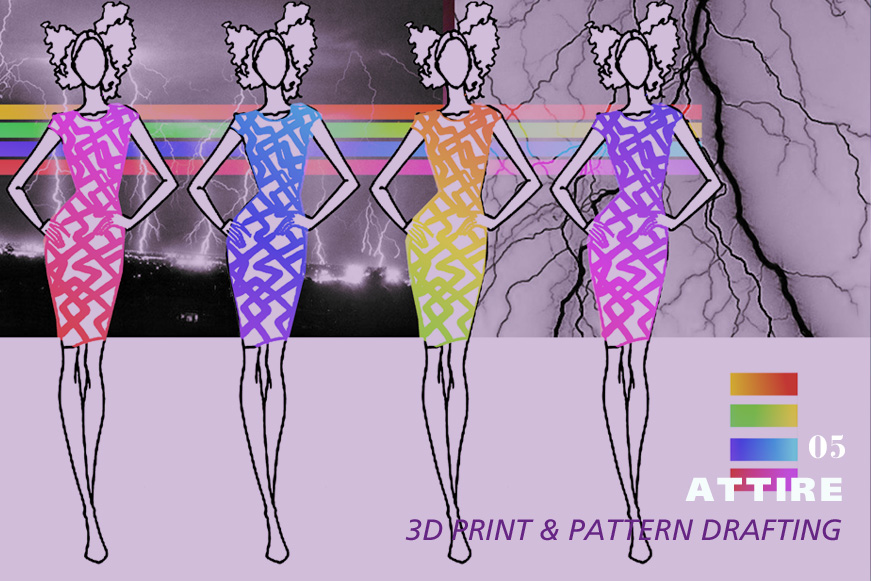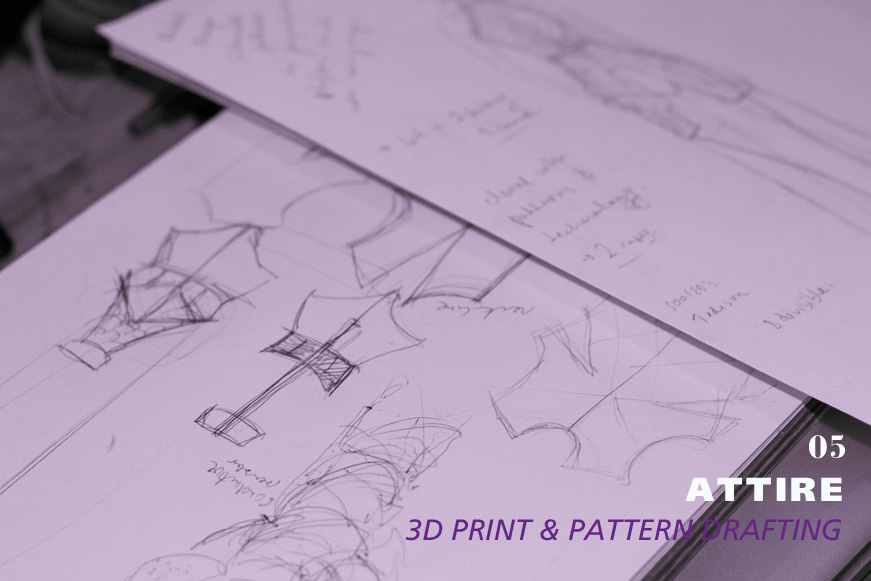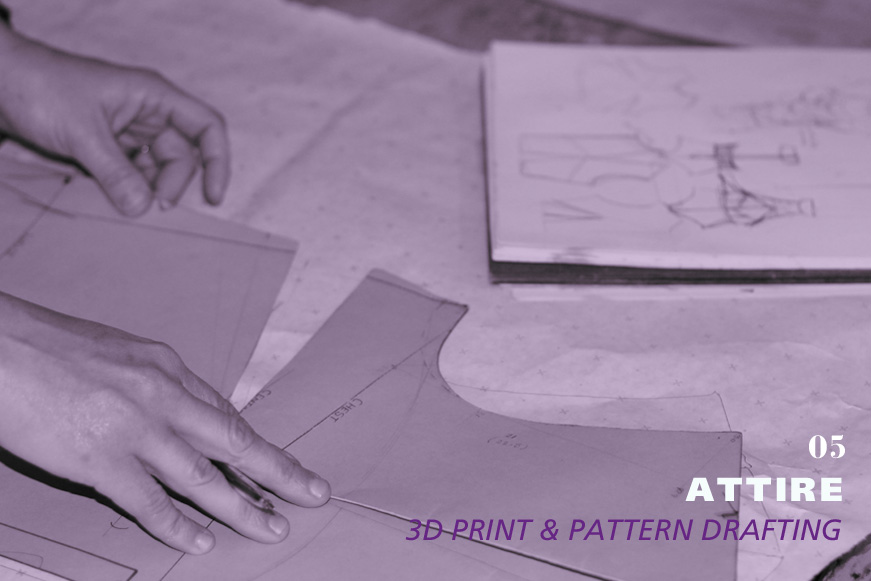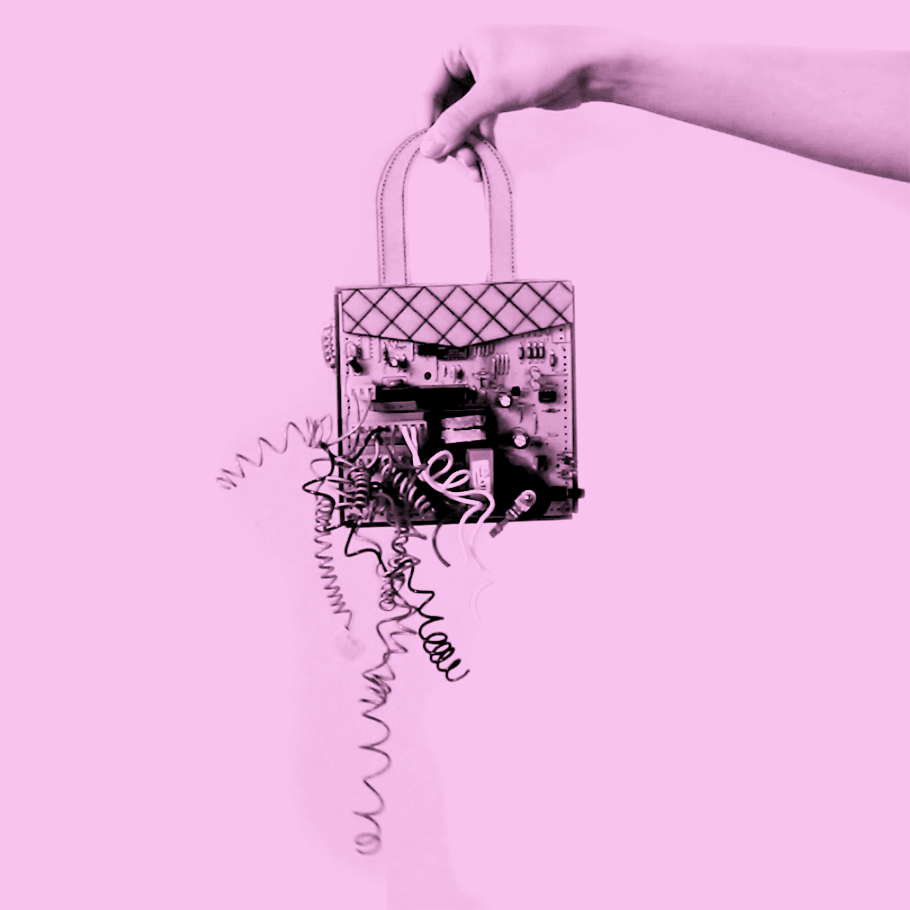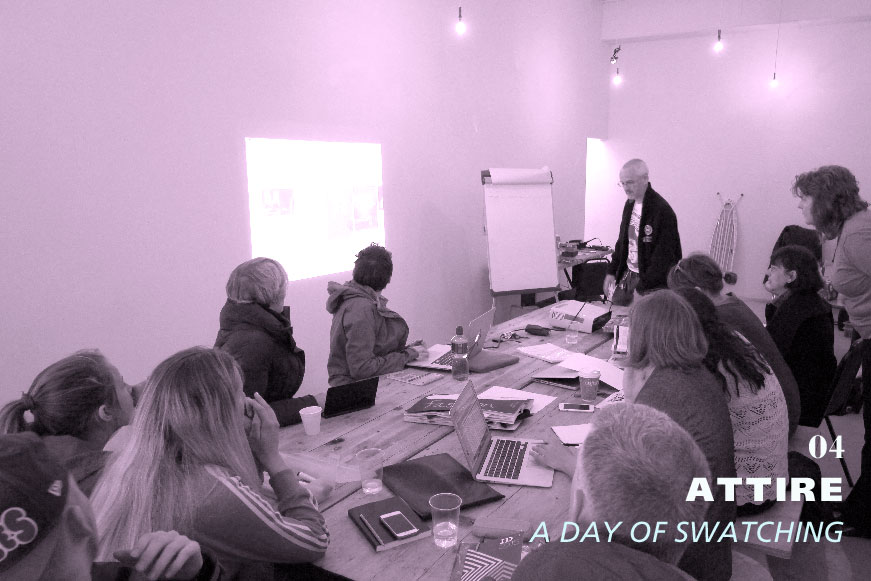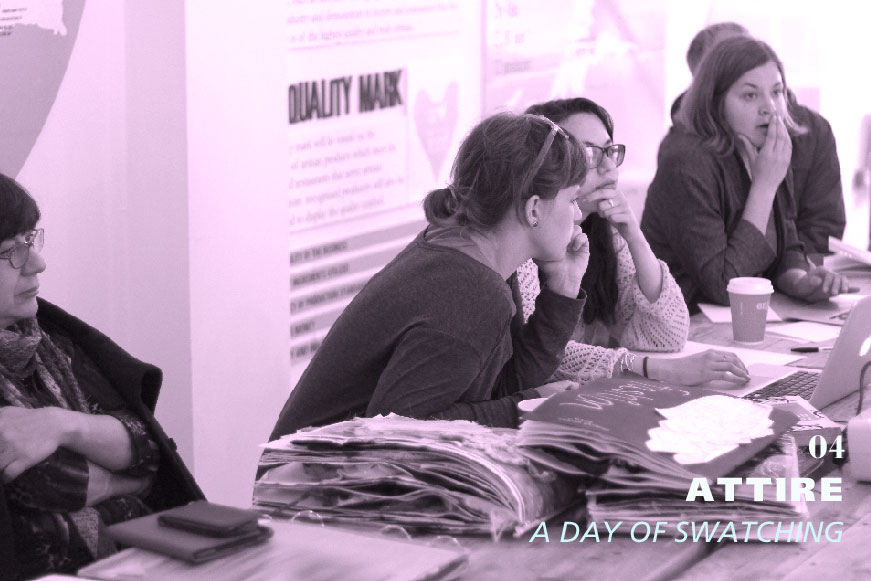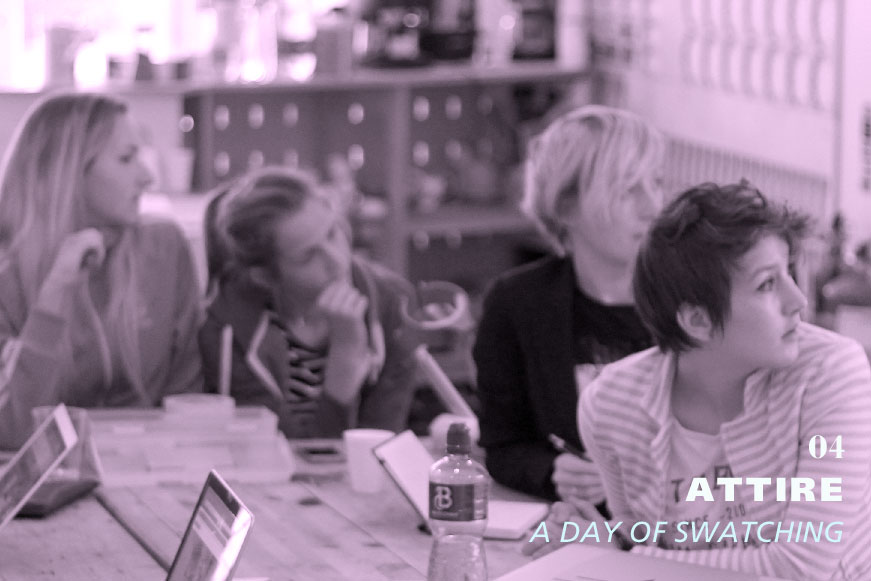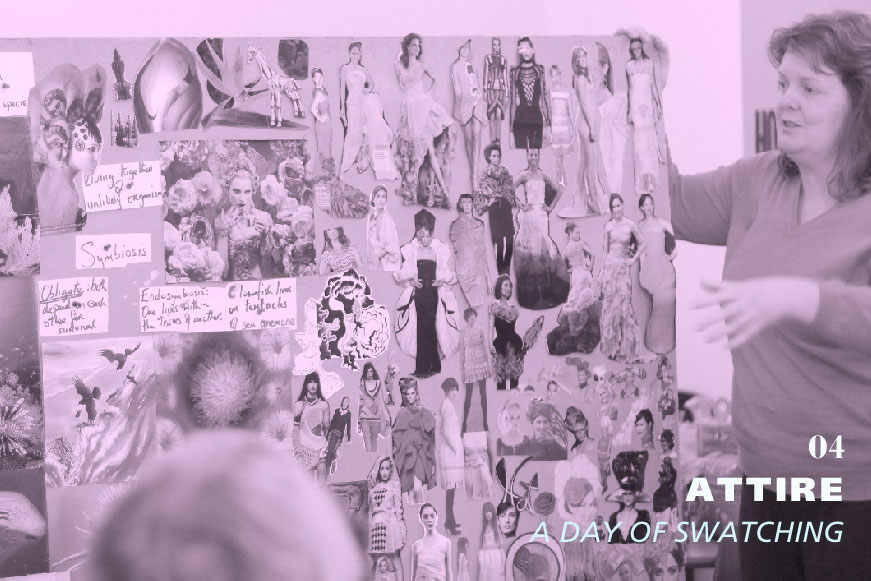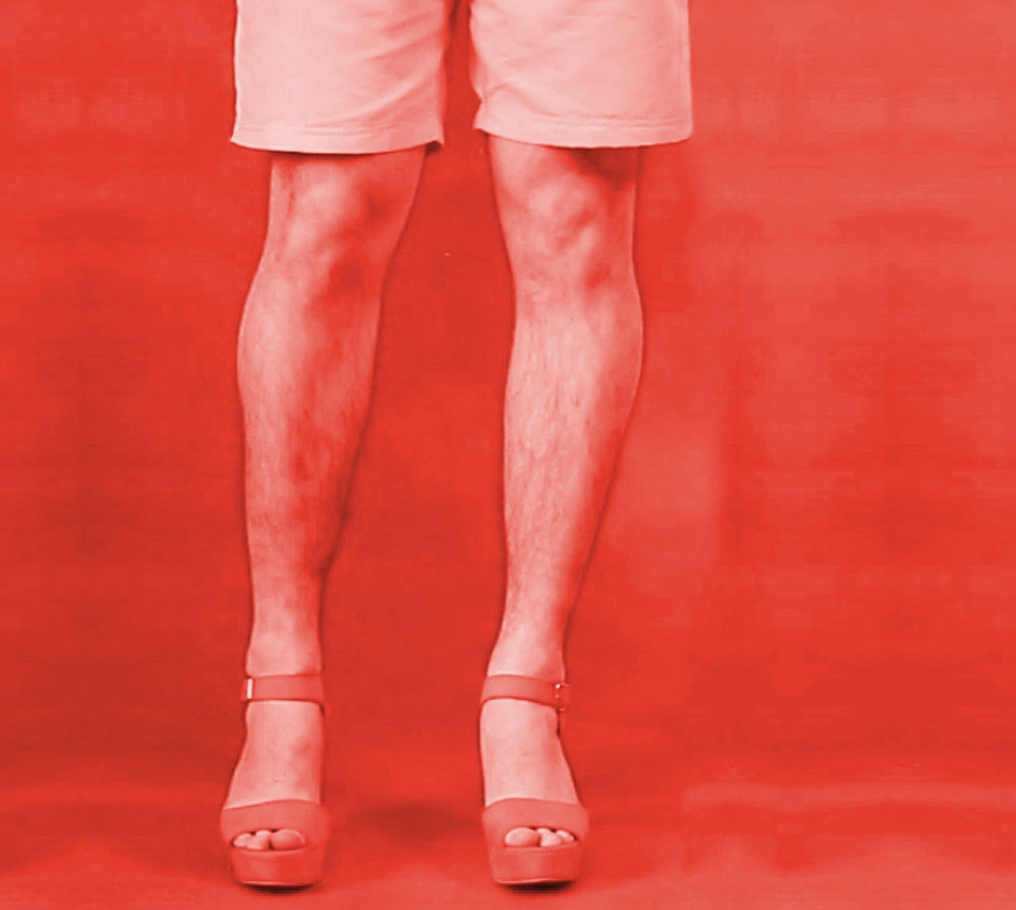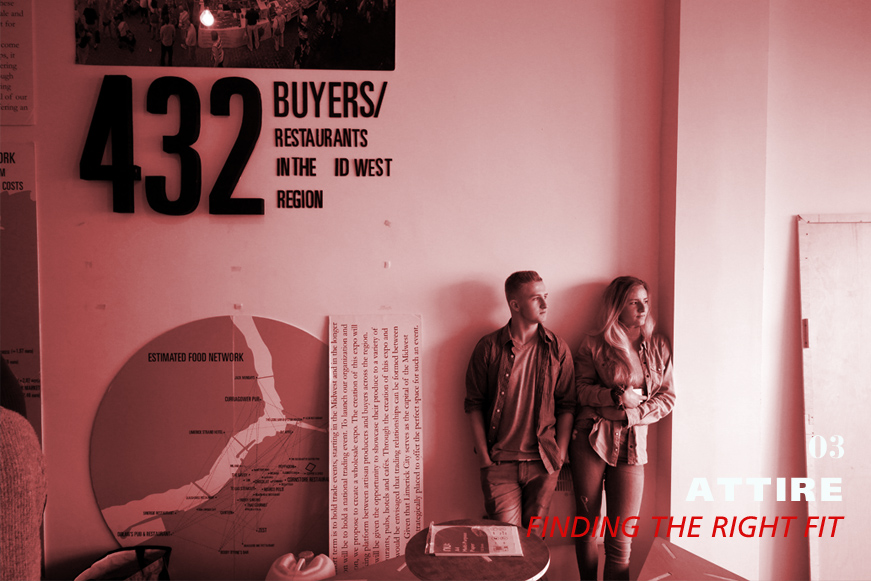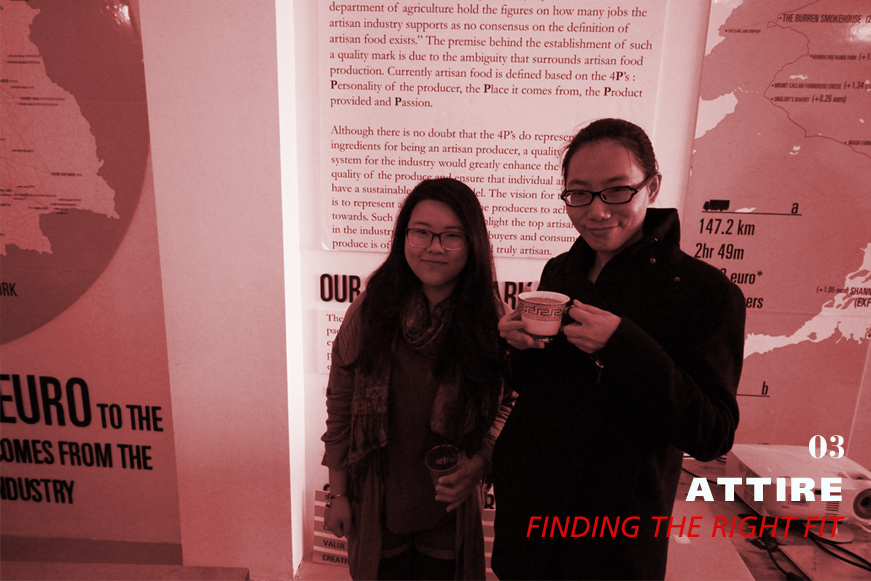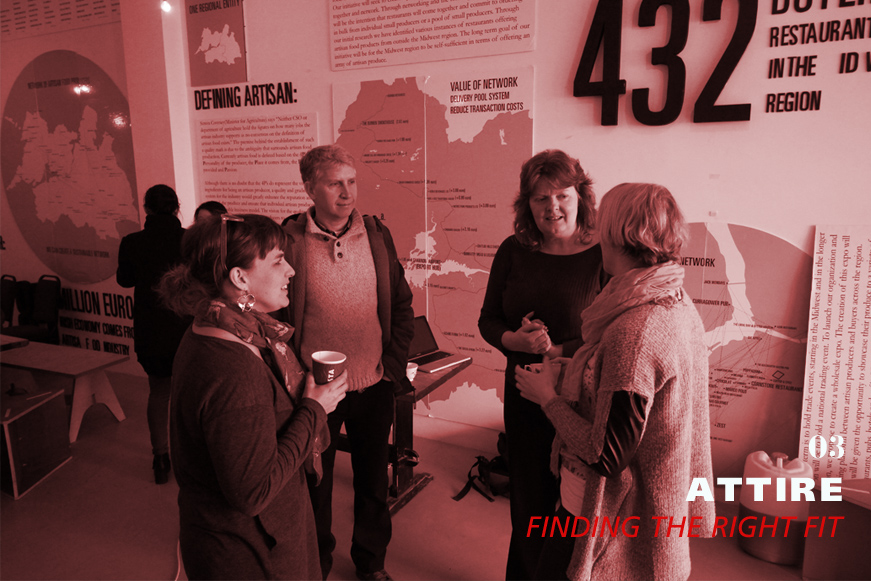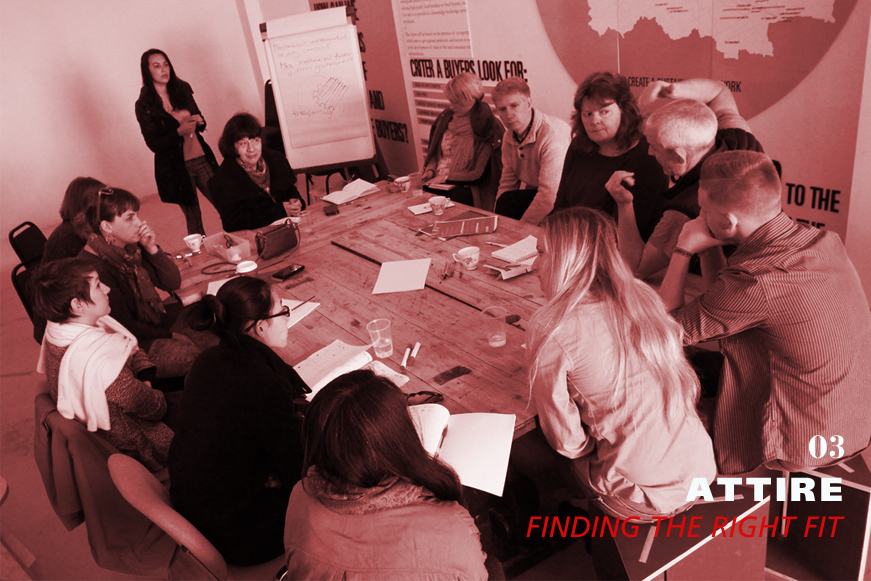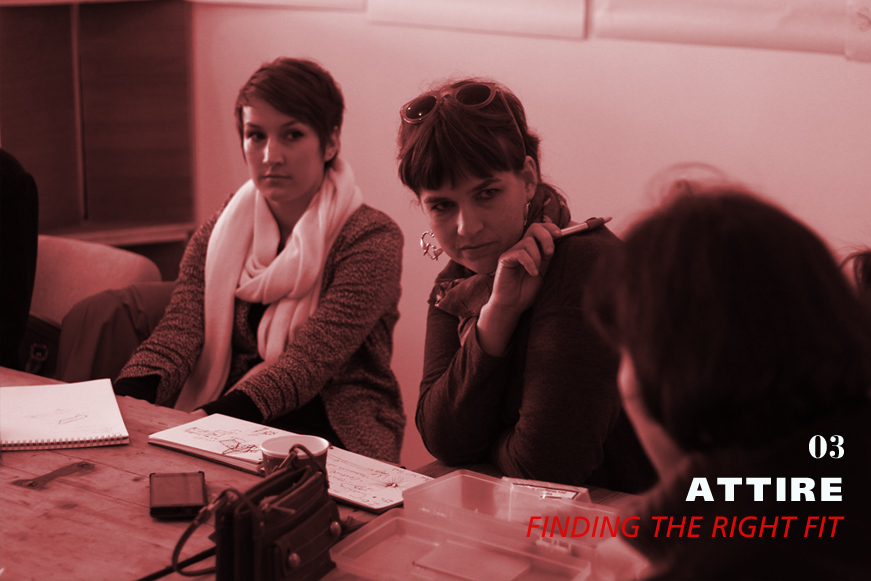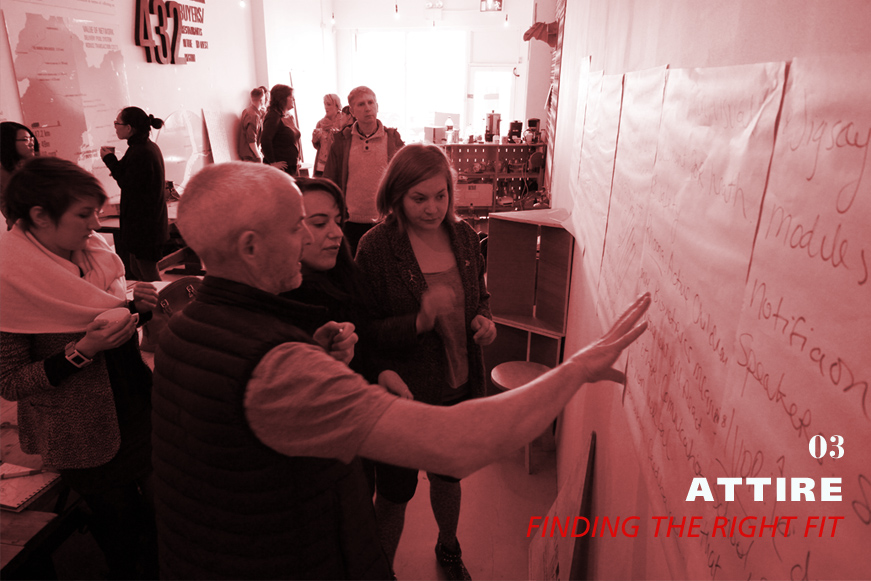All posts by sml
Final Event 06th of October 2015
ATTIRE
Advanced Technology & Textile
Inventive Research Events
Event 08
PROTOTYPING – 02
PROCESS
On our 08 event the womenswear outfit is physically starting to take it’s shape. Lucia made a symmetrical draping on the mannequin with yarn for the LED placement previous to the workshop. Miia photocopied LED strips and they were placed around the mannequin in the LED assigned areas to evaluate the amount of LEDs we will be using. It contains roughly 731 LEDs in 18 channels. The A second toile was made following the new design and was fitted on our teen model Elizabeth on the day. A few minor adjustments will have to be made but it fits and holds it’s tightness.
We can now purchase the neoprene fabric we will be using to construct the final women’s wear garment. Prior we had to make a decision on the colour story. As the LED’s will be the main colour display, we want to keep the fabric colours neutral but also have impact when the lights are off. White, black, light grey, nude and small amounts of burgundy are our chosen pallet. 

These colours have a fresh and young impression and will be carried through to the men’s wear outfit.
In the 07 workshop we had discussed the idea to include an external 3D printed piece as a form of a jacket or detachable. Mariel designed a Chinese origami inspired jacket .The jacket will have a combination of fabric and 3D printed pieces. The 3D printed elements will be mostly contained to the sleeves and made up of smaller parts. We found an experiment origami inspired to create 3D printed textiles by Meg Grant in 2012 http://www.meggrant.com/3d-
Ivor recreated the experiment.
“Instead of printing directly to material, I though it would be worth printing a similar pattern design but with flexible plastic (NinjaFlex) as the base material to act as the hinge.” (Ivor)
The pattern was first drawn up in three dimensions in Sketchup, ensuring the pattern shapes were raised higher than the base. The design is exported from Sketchup as an STL file, and is imported and sliced in preparation for 3d Printing. In this process (visible below) you can estimate the of the length of flexible plastic (NinjaFlex) that is needed to form the first two layers of the print.
The design is exported from Sketchup as an STL file, and is imported and sliced in preparation for 3d Printing. In this process (visible below) you can estimate the of the length of flexible plastic (NinjaFlex) that is needed to form the first two layers of the print.  As the pattern is printing the flexible plastic (NinjaFlex) is changed for a harder plastic (PLA) after 755mm has been fed. This will have allowed two full layers of the object to be printed in the flexible plastic, and the remaining part of the pattern, the raised shapes are then completed in the harder plastic.
As the pattern is printing the flexible plastic (NinjaFlex) is changed for a harder plastic (PLA) after 755mm has been fed. This will have allowed two full layers of the object to be printed in the flexible plastic, and the remaining part of the pattern, the raised shapes are then completed in the harder plastic.  We used this modified sample and sowed it to organza but the fabric is creating to much pull and the folded shape is difficult to contain.
We used this modified sample and sowed it to organza but the fabric is creating to much pull and the folded shape is difficult to contain. 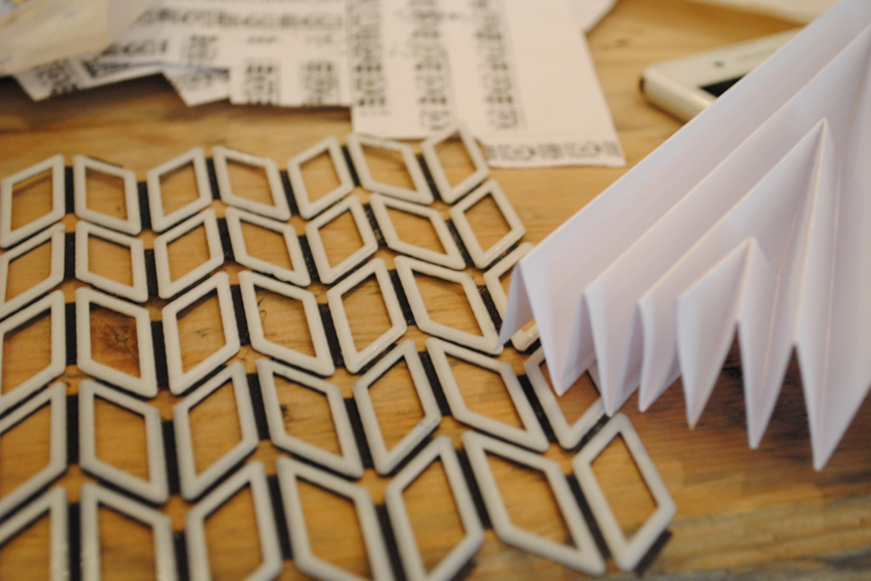
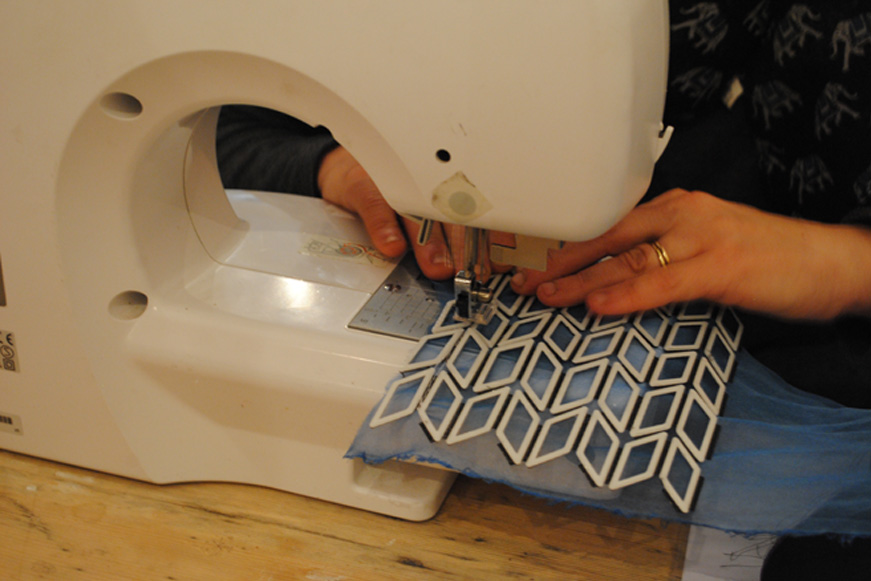
The Illustration Mariel created for the 3D printed sleeves is made up of triangular folds and resembles the method to use a flat print and be able to fold it to give it it’s 3rd dimension. Meg’s experiments showed us a process to try various visually interesting origami techniques to construct the jacket.
Dave had also made some LED shoes that we are thinking of using for the men’s wear outfit. The lights are very bright at the moment some modification to diffuse the light will have to be designed.
FINDINGS
During this workshop, the engineering team were tasked with making up a few dozen of the cables designed in previous prototyping sessions. These cables will join the LED strips when placed in the garment, and are made of two 3-way connectors joined with highly flexible silicone coated wire.
The arrays will zig-zag which reduces wiring, and allows minimum thickness for the whole array. All in all, the LED grid arrays are no thicker than 2.6mm. Because the LED strips are made from a
thin flexible PCB, they have a tendency to during use, so easy maintenance was a key design feature. Using this connector system allows a broken strip to be removed and replaced within
minutes, no soldering or sewing required.
EVENT 07
PROTOTYPING – 01
We are now right in the swing of solving the women’s wear garment. During our 07 event on Saturday we re-created a section of the RGB array of LED’s swatch and incorporated it into the textile swatch. This was a key step as we had to see how we would manoeuvre the wiring to not disturb the tight fit of the dress. Simultaneously, we were working with the toile to assign the LED placement within our garments. We are also dabbling with the idea to include some geometric 3D printed pieces in form of a detachable or as an extra element to the garment such as a jacket to give it an extra wow factor as it is an exhibition piece.
PROCESS
Earlier in the week the textile swatch was refined using black neoprene fabric, with an additional laser cut perforated texture to the textile tubing carrying the LEDs. With the new textile swatch Dave adequately showed us the exact requirements for wire connections and how they can be manoeuvred for different lengths. The women’s wear toile was also ready made with clever asymmetrical seems to hold the panels and assure it’s tight a fit. Mia drafted the pattern and Marie put the toil together. With this visual we were able to begin figuring out and assigning the LED placement. Whilst looking at the dress in it’s real proportions Rhona and Mariel thought of adding 3D printed inspired origami triangle shapes mimicking the geometry of the dress. This will be cleverly designed as another way for the light to travel.
FINDINGS
We had an informal meeting the previous Thursday to discuss the best method of wiring which would create less bulk and less likelihood of breakage. The conductive thread’s behaviour is difficult to contain, master and it is the most likely to break, it also doesn’t carry enough power needed. The silicone cover wire is for now the best solution, it doesn’t create much bulk and its performance is a lot more manageable.
The new textile swatch proved to be very successful in its design to contain the LED’s and assist an easy fix if needed, flexibility for different lengths of LED strips, room for wiring to be applied and it is visually appealing. The perforated pattern broke the single LED light into 3 smaller lights giving the illusion of having many more LEDs placed. We will continue to experiment with various textures to manipulate the light as it was proven to be a successful technique through out our workshops. The placement of the LED’s presented to be an issue as the individual areas of the toile were to large and some of the shapes were not suitable to include the LEDs grid for efficient programming. We need to be clever with the seems as the more seems the looser the fabric. We worked with the asymmetrical assigned areas within toile and broke it down into smaller parts by adjusting the textile rather than adding more seems . Although some of the areas were not adding up so we will have to revisit the pattern and the toile’s construction. Our best solution is to go back to the drawing board and decide the LED placement first keeping in mind the swatch and its integrity.
EVENT 06
3D PRINTING & PATTERN DRAFTING / 2
Saturday workshop was very straight to the point as we were looking for the possible solutions for the issues addressed on Thursday. The individual issues and proposed solutions are further described under electronics issues and fashion issues.
Electronics Research Summary from Workshop 05
The electronics group were tasked with two main research areas for this workshop:
- Detecting touch from a specific source
- Accurately detecting distance between the two garments
Touch:
It’s relatively easy to detect a touch to our garment – It is more of a challenge to detect a touch from a specific source. All touches to our garment register the same way – This is not a bad thing. It keeps our battery life down, sensor profile slim and complexity low… But it means the information coming from these touch panels is simplistic, on or off. This is not good enough to be able to distinguish between a touch to our garment from an observer and the fellow performer. So what’s the solution?
Our two proposed touch solutions rely on the same basic principal, confirmation. The two garments will communicate with each other about who has been touched and who is touching. A garment which has been touched, will listen to see if the other garment says that is is currently touching something. If this is true, we can assume with relative certainty that the garments are touching and we can ask the touched garment to react accordingly.
Solution one involves a button concealed in a cufflink or other wired button which when pressed, will put the garment into “touching mode” for 5 seconds or so. If during this time the second garment is touched, it will react. This solution while easy to implement has the limitation of needing to be wired – which means it is harder to conceal – and it interrupts the natural movement of the pair while pressing the button.
Solution two is mostly the same as the first, except that it will be wireless and thus much easier to conceal in an accessory or piece of hand worn jewellery, such as a ring. The button may also be replaced by a touch sensor similar to the touch pads on the garment itself, making the touch gesture more natural. Finding a stable (and small!) method of wireless communication is the challenge with this method.
Distance:
The problem of distance measurement between two specific objects (without the need to point a sensor of some kind) within an enclosed environment is one without an obvious, off the shelf solution.
Both Wifi and Bluetooth signal strength are too variable to rely on owing to the differing signal patterns from device to device and the effect competing signals have on signal strength.
Traditional ultrasonic distance sensors also would not be suitable. If you’ve ever had a bat’s echolocation explained to you, this is the same stuff. Usually, one ultrasonic device sending out a pulse measures the length of time it takes for it’s own echo, which has bounced off the nearest object, to return.
This solution does not suit us because we only want garment A to light up in response to garment B, not in response to an approaching wall!
Our solution, proposed by Dave Hunt, is to use traditional ultrasonic distance sensors in a non traditional manner. We will be using 2 devices, one on each garment.
The way this will work is when the first device sends out a pulse, it will stop listening for replies for a defined amount of time, T. When the second device hears this sound, it will wait for the same amount of time, T, before sending a response. The first device will pick this response up and be able to calculate the distance based on the amount of time it took for the “round trip” of signals to happen.
The use of delays in this solution is required in order to ignore the initial echo effect upon which the usual operation of these ultrasonic devices depends on.
Fashion Research Summary from Workshop 06:
The fashion group had these two main issues to address and try to come up with suitable solutions
- Incorporate grid LEDs display for complex animation into the tigh fit dress without loosing the integrity of random LEDs strip pattern
- Design the innovative and contemporary menswear outfit that would be directly synchronized with the dress
Why is the random placement of LEDs strip important?
Textile manipulation that we are going to use based on the swatch Lucia made to ‘hide’ the LEDs in the dress is sustainable and interesting. It uses the LEDs strip placement to create a 3D lifted pattern/texture around the dress. This results in displaying rather than hiding the LEDs even if the lights are off. It is one of the reason why we want to keep the visual integrity of random placement. Another reason is to use the LEDs in a more innovative and unpredictable way rather than a square screen. Random routes of the LEDs strips are also essential to show effectively the ‘traveling light’ animation when the dress is touched /activated.
Why is the grid placement of LEDs is important.
To achieve the maximum from the animation we need to have the LEDs placed in the grid. The software that can scan any image and translate it into the animation. This is a crucial feature to allow the dress to animate on a higher level. Our goal is to achieve the maximum space for the complex animations together with seemingly random patterns.
What to be aware of in relation to the fashion appeal?
The dress is designed to be a tight fit so we need to be clever and inventive about how to achieve it’s fit. We can run into danger if the combination of LEDs with a tight fit and sheer treatment could end up looking like a bodycon of the rack with Christmas lights, rather than hi-fashion wearable tech garment.
Solution
To combine the tight fit, random LED strips and the square grids of LED’s, we decided to draft the dress pattern into a number of small parts. When put together tight fit will be achieved by cleverly cut seams and darts rather than by a stretch fabric. This will also give us an opportunity to create some of the pattern pieces into grid displays. These pieces will carry out the main animations by keeping the integrity of the grid display. Dress parts displaying the animation will seemingly connect together by the individual – random LED strips. These will keep the visual appearance of a connection between individual animations. Also these individual bridges will carry the animation of the light traveling from the dress towards the sensors when touched.
Our next step is to pattern draft the dress form to assure the tight fit and assign the pieces that will carry out the grid animations.
Menswear
Initial design for the menswear is to create a long shirt /dress. These can be worn in combination with the skinnies. The longer shape will highlight the futuristic nature of the design. The LED display will be complimentary to the woman’s dress. When touched at the sensor the ray of light will point towards the sensor. This idea will create the illusion where the ray of light from the men’s shirt travels into the woman’s dress and creates a reaction like a lighting bolt.
EVENT 05
3D PRINT & PATTERN DRAFTING
Last week was very busy and exciting as we hosted two workshops. The couple of hours on Thursday flew by as we had loads of big decisions and calls to make. We worked out an idea of how the garment will function and now is the time to apply it.
PROCESS
ARRAY of LEDs
For the swatching and garment design workshops, we built an array of RGB led consisting of 64 LEDS laid out in a grid of 8 x 8. Each line of LEDS were approx. 20mm apart. This allowed us to place various various materials over the array while an animated pattern was being rendered to see the effect through different materials. The array was powered by a 2500mAh 3.7v Lithium Polymer battery, and driven by a FadeCandy board. The FadeCandy is designed specifically to drive large arrays of RGB LEDs, and renders the colours in a much more pleasing way than other micro controllers. For the workshops, we were driving the patterns using a laptop, using demo FadeCandy software but the plan is to replace the laptop with Intel Edisons (running custom software) for mounting into the garment, as they are far smaller, and very suitable for wearable projects.
Dave showed us some very interesting examples of how to run images or patters through it. It would be a very effective and straightforward solution to accommodate the LED display. Mariel made a set of colorful rorschach images that she wanted to display on the garment and this prototype was a perfect example of how easily they could be projected on a garment.
3D PRINTED DIFFUSERS
Previous week Ivor introduced us to the essentials of the 3D printing. He printed out number of various little hollow domes that diffuse the light from the LEDs. 123D Design was used to draw the shapes. http://www.123dapp.com/design
More box like shapes that could be used to protect electronics and batteries were also looked at and test printed. Shetchup can be used to draw such objects… www.sketchup.com
General 3d printing design repositories were also briefly looked at including http://www.youmagine.com www.thingiverse.com
We also played with a neat free utility for converting jpeg images to 3d printable shapes http://3dp.rocks/lithophane/ which might be of value. We aim to incorporate custom made 3D printed light diffusers in various shapes and sizes. These diffusers could replace the traditional embellishment.
We tried out various textile materials and swatches made earlier as diffusers and got some very interesting results and effects. This exercise was decisive in picking out the materials and textile manipulation techniques that are effective and suitable for showing the LEDs the way we want. At the moment the biggest challenge for us is to make a garment that is clever and innovative due to the use of technology but at the same time trendy and desirable for teens on a fashion plate!
TEXTILE SWATCH
Lucia introduced her initial design of the garment. She created a textile swatch that incorporated the LED strips into the fabric in a clean and interesting manner. This way the garment will look complex and unique even if the lights are off. Her dress design was influenced by the direct electronic concept. The intensity of LED display changes depending on the distance between the two outfits (the closer the brighter) and animates by touch. Sensors will be placed on shoulders, waist & hips. The animation will work like a plasma bulb, once touched at the certain sensor the light will travel to that sensor in two hues of color from all around the dress. Each sensor changes the route how lights travel and uses different hues. After the ‘lighting’ animation the dress will light randomly – with hues of two colors animation assigned to the sensor that was touched last, until touched again.
To make this work we need to figure the electronics that enable outfits to react only to each other and to measure the distance between them.
At the moment the routes of LED strip on the dress are in a random criss – cross, zig – zag pattern. This is a very specific way of display that is visually pleasing but the number of animations that could be displayed is limited as they only can be displayed in a single strips. The textile solution of attaching the LEDs to fabric is very interesting and it is something that we are going to use however we need to revisit the placement of LEDs on the dress. To show various animations the LED would have to be placed in a square grid. This is a obvious use of LEDs as a screen of sort and it is different to the final effect we want to achieve. The current placement is not very feasible because the LEDs are incorporated in a labor intensive rather than effective manner. We have to come up with a compromise solution that accommodates the function and elevates the design.
After a short discussion we decided to create a short jumpsuit and Miia started pattern drafting.
For the next session we still have to finalize the menswear part of the outfit and re-evaluate and redesign the dress. We discussed the idea of designing an oversize transparent multi- textured jacked – to go over the dress. This solution would maximize the textile part of the workshop and it would serve as an additional light diffuser that can bring our outfit to the next level.
EVENT 04
A DAY OF SWATCHING
PROCESS
Our forth event started with great presentations of the possible form. Number of participants came up with interesting and unique concepts that would accommodate the electronic function of the garment. With a rich visual aid in form of mood boards we all started to have a better idea of what kind of garment we’re going to construct. The term symbiosis was a popular choice for the secondary inspiration and a chunk of the visual inspiration was taken from the flora and fauna kingdom. Dave gave us a run through the number of various electronics that we ordered for the experimentation and explained to the group how they need to be put together. It was very helpful and informative for the fashion designers and dressmakers to see and understand how the electronic elements need to function within the garment. Mia brought a few textile swatching sketchbooks from her students to give us an idea of what the swatch is, how can it be made and what is it purpose. This part of the design process is very important especially within this project as we are combining various materials. Rhona came up with a number of interesting ideas how to use static electricity from touch to generate movement of some nylon materials. This is a very interesting idea that could be introduced in the garment. We had a selection of fabrics, ribbons, sequences and beads ready for experimentation and we were able to try out numerous techniques. We also had the laser cutter at the ready and Mariel created possible patterns on how to manipulate light. Over the coming days we will create more textile swatches so we can combine them with electronics at our next event.
FINDINGS
During the day it was clear that our group has a very strong and professional dynamic. If a problem or an issue arised we were able to find a possible solution very quickly. Also it was the first event where we started physically making things and it was a great experience. There is still a lot to do with textile experimentation but most of this work will have to be done outside of the workshops as it is very time consuming. However we had time to go through some of the typical and suitable techniques like pleating, honeycomb pleating, knitting, combining materials, embroidery and laser cutting. We compared and evaluate the materials that we have and planned some swatches together. We will bring all the swatches done outside the workshop along on Thursday evening where we will add on some 3D printed elements to our portfolio.
Short promo video from our 3rd event!
FINDING THE RIGHT FIT
EVENT 03
FINDING THE RIGHT FIT
PROCESS
Our 3rd workshop took place on the 11th of April at 10am in the Makers room at Fab Lab Limerick. Early start on a sunny spring Saturday morning to finalize the function concept and have an initial discussion for the form of our garment. By now we have a core group of participants and we are getting to know more about each other each time we meet, as well as a few new comers with a fresh outlook and enthusiasm on the project.
We arrived prepared with narrowed down ideas (as we specified in the homework) for the function based on the initial concepts from our last workshop. This time around we had to choose one final idea to continue through out the rest of the project. We wrote all the ideas on our flip chart paper and discussed them as we went along, tightening up any loose ends. We put up our sheets of paper on the wall and had a 10min break to take it all in and think about our preferred selection before we put them to a vote.
After break Dave Hunt went through the function possibilities and limitations for each idea before we voted. It was difficult to pick the one but we came to a conclusion and smoothly agreed.
A lot of the ideas put forward overlapped with the technology involved so we feel comfortable and confident that the remaining ideas will be developed in the future. We had allocated one hour for this part of event but it ran though to an hour and a half. As this is the very important and decisive part of the whole project we dedicated as much time as needed to finalize the function without rushing.
Once we had our function and our market decided we started discussing the visual opportunities and a ways of how to approach the initial design of the garment.
At the end of the event we evaluated the skills within the group and mapped out what kind of equipment and materials we can individually offer to the workshops.
FINDINGS
The final idea for our function – synchronized formal wear for a trendy and fashion forward teen couple – means there will be visual communications between two garments demonstrated by light patterns or colors based on a touch or a movement.
As a starting point we will design one garment as a part of womanswear and one garment as a part of menswear. Once these initial designs are resolved concept can be easily applied to various couples.
We also found that the technology in the function ideas overlapped and some of the other ideas can be implemented within.
Understandably the primary source of inspiration is derived from the electronic and real function of the garment.
The secondary source of inspiration is based around either one of these terms :
symbiosis, metamorphosis or equilibrium
Now that we will be tackling the form we are starting a group board on Pinterest where we can share our visual inspirations to create common mood boards.
We will also keep constant communication on the Facebook within the group to share our findings and ask questions.
It is important for us to share various different available electronic components we can use as the fashion design will have to be made accordingly to accommodate them.
